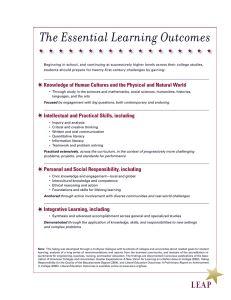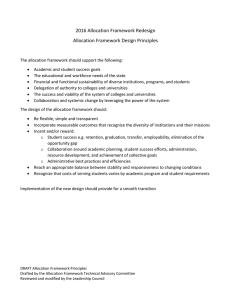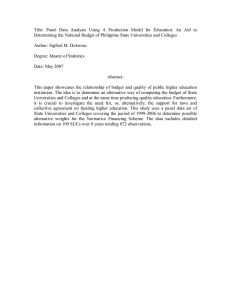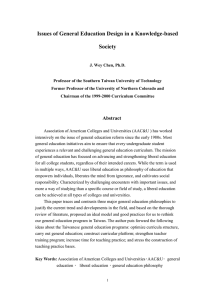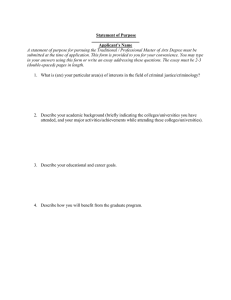Embedding Social Inclusion in Universities Adam Howard Colby College
advertisement
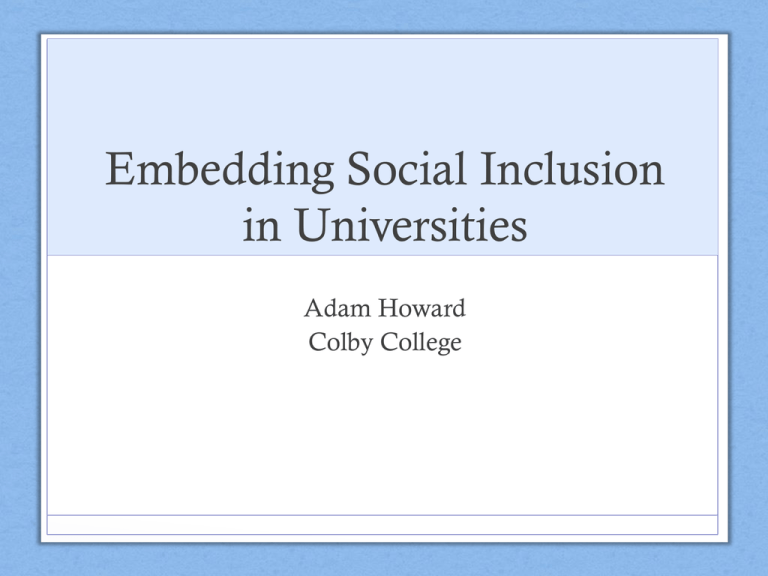
Embedding Social Inclusion in Universities Adam Howard Colby College Research Process • Phase 1: Library Research • 36% of low-income students attend higher education institutions, compared to 88.3% of high-income students • Research focus only on increasing enrollment, not retention • Late 1990s stopped compiling national data related to SES • Phase 2: National Center for Education Statistics and College Board • Lawrence Gladieux and Watson Swail found only 6% of low-income students receive degree within five years • 9% receive receive degree within six years; Some Consequences of Dropping Out • Many low-income students who drop out of university are worse off than if they had never attended in the first place. These students leave postsecondary education with no degree and, most of the time, a debt to repay (In Australian context, a wasted investment) • Feeling a sense of failure, decreased self-esteem and confidence • Studies show that some of the common effects of dropping out are family conflicts, limited career options, lower earning potential • Millions of Americans are taking on the debt of college without getting the earnings boost that comes from a degree. Those who dropout are more than four times as likely as graduates to default on their student loans. Common Misconception • It’s only about the costs of attendance • The main factor in the higher drop-out rates, according to a recent Harvard study, is the rising cost of a college education. The cost of college has nearly sextupled since 1985 and the total amount of student loan debt held by Americans surpassed $1 trillion in 2011. Research Process • Phase 3: Evaluation of Programs at Universities and Colleges with highest rates of retention • Phase 4: Interviews with students who dropped out • academic skills needed for college • the financial means to cover the expenses beyond tuition • the level of self-esteem and confidence necessary for overall success Necessary Systems of Support Academic Social Financial Academic Support • Pre-university Academic Programs • Intensive academic preparation programs within students’ communities • Summer intensive programs (1-2 months before officially entering) • Academic Advising • Before students arrived on campus through the first year • The ins and outs • Academic Retention Circles • Collaborative Approach to providing support • Early outreach to students Academic Support • Professional Development Opportunities for Professors • Adopting new pedagogical approaches/changing practices • Addressing students’ academic needs • First-year course requirements • For example, main goals of one course are to help students become better writers and readers, to get them more familiar with the library, and to become more comfortable with using technology for academic purposes. Students who need to significantly improve their reading and writing skills attend additional tutoring sessions. Social Support • Orientation Programs • First-Year Common Experiences • Courses • Civic engagement experiences • Meaningful Contribution/Connection to the Institution • Barriers: Lack of time because of work and other obligations; potential additional costs • Student-led initiatives Social Support • Similar/Same Social Connections Prior to Enrollment • Establishing relationships with families • Mentoring programs • Peer Support Groups • Barriers: May be potentially counterproductive • Establishing relationships with others with similar backgrounds and experiences Financial Support • Financial Counseling • Doing more than required: to provide students suitable amounts of financial aid as determined by their levels of need, to inform students about their responsibilities in accepting this financial aid, and to comply with federal regulations. • Offer workshops, one-on-one meetings, presentations, and other methods in order to effectively establish lines of communication and establish relationships with college officials responsible for services related to financial aid, loans, etc. • Providing students guidance to make informed financial decisions about their future and to begin financially planning for life after college Financial Support • Helping Students Manage the Hidden Costs • Transportation, expenses related to units/classes • Providing computers • Reduce the costs of textbooks and class materials • Employment services/on-campus opportunities • Community/University partnerships • Career Advising from the start • Learning how to take advantage of social networks Effective Practices • Addressed all three forms for support • Didn’t try to do everything. In fact, the most successful efforts were focused ones – institutions directed resources and energies toward small number of programs/services • Designed and implemented programs and services specific to the institution and their students Deficit Perspectives • Sonia Nieto (1996) defines cultural deficit perspectives as those that: “Hypothesize that some people are deficient in intelligence and/or achievement either because of genetic inferiority or because of cultural deprivation (because of their cultural background and/or because they have been deprived of cultural experiences and activities deemed by the majority to be indispensable for growth and development).” Colby College • Founded in 1813, it is the 12th-oldest independent liberal arts college in US • 1,815 students; 10:1 student-to-faculty ratio • Ranks among the top 20 liberal arts colleges in the country • $59,110 per year comprehensive fees • 39% of students on financial aid (therefore, 61% do not qualify for financial aid) and $25 million in aid awarded each year • 11% first-generation students; 19% students of color; 11% international students (from over 70 countries) • First Year Student Retention: 94% • Overall Retention Rate: 91% • Latino 51%; African American 73%; [1st gen 42%] The “liberal arts college experience” in the US is characterized by three main aspects that distinguish it from undergraduate experiences in other countries: • smaller size than universities, which usually means more individual attention is given to each student; • residential, which means students live and learn away from home, often for the first time, and learn to live well with others; and • a typically two-year exploration of the liberal arts or general knowledge before declaring a major. Posse Program Mission › The Posse Foundation identifies public high school students with extraordinary academic and leadership potential who may be overlooked by traditional college selection processes. Goals › To expand the pool from which top colleges and universities can recruit outstanding leaders from diverse backgrounds › To help these institutions build more interactive campus environments so that they can become more welcoming institutions for people from all backgrounds › To ensure that Posse Scholars persist in their academic studies and graduate so they can take on leadership positions in the workforce Posse Program Program Components › Scholars receive full-tuition leadership scholars › Recruitment and Selection - Dynamic Assessment Process (DAP), a unique evaluation method designed to identify young leaders who might be missed by traditional admissions criteria, but who can excel at selective colleges and universities. Performance-based assessment. › Posse Foundation provides a pre-collegiate training program › Colby provides a campus program to ensure the retention of Posse students – Mentor meets with scholars individually for 1 hour every two weeks, 2 hours collectively per week › Career Program › Posse Access is an online database to give partner universities and colleges exclusive access to unselected student nominees Within the affluent, white culture of Colby, their outsider-within status had begun to take shape. While just starting to identify as a part of Colby, they also were beginning to realize that they would be apart from it. New England Consortium on Assessment and Student Learning (NECASL) Participating institutions › 5 coed and 2 single-sex liberal arts colleges in New England General goals of the project › Understand transition from high school to college › Understand academic and social decision making › Explore learning in relation to institutional practices › Involve faculty and students more directly in assessment › Share institutional research findings › Improve educational experience of students Results from Third Year Survey Class Dorm Meals Sports Student Orgs Economic background 75.3 64.1 61.8 25.4 44.2 Race or ethnicity Personal values 79.8 75.0 77.7 73.9 63.4 60.0 60.1 60.4 66.3 59.3 60.6 58.2 24.5 22.8 21.4 23.7 48.0 42.5 44.4 41.1 Political beliefs 73.1 51.8 52.1 20.7 36.5 Sexual orientation 64.8 48.6 49.6 15.1 38.5 Religious beliefs Cultural background Students saw classrooms, much more than social encounters, cultural events, or other out-of-classroom experiences, as important arenas in which genuine interaction around diversity occurred in a safe environment. Course Background/History • 2008-2010—president-appointed working group • JanPlan 2011—year 1 (18 students; 4%) • JanPlan 2012—year 2 (75 students; 17%) • JanPlan 2013—year 3 (120 students; 27%) • Projected for 2014—year 4 (140 students; 31%) There are roughly 450 first-year students Knowledge and Skills Associated with Multicultural Literacy • accepting and respecting differences • becoming aware of one’s own culture/background and biases, and the effect these realities may have on people whose culture/background/biases are different • understanding the dynamics of power, privilege, and oppression, and how these dynamics impact interactions across differences • developing skills to communicate across differences, to manage conflict in positive ways, and to intervene in negative situations Course Goal To provide knowledge and skills that will enable students to interact effectively with others across multiple dimensions of difference. Structure/Syllabus • 1 professor, 2-3 student teaching assistants in each class • Teaching assistants are fourth year students • Course is structured around major identity categories—gender, sexuality, race, class, ability, religion • Individual/Cultural/Institutional Levels • Capstone Action Project Understanding the concept of unearned privileges You consider yourself as having racist attitudes, beliefs, and feelings What It Means to be an “Ally” Learning Outcomes • A More Critical Awareness • Deeper Understanding of Self and Others • A Stronger Commitment to Engagement • Dialogue Across Differences Student Feedback • “I learned that I actually can make a difference with these issues. I do have the power to get things started and to stand up for these groups and make a difference.” • “I am more privileged than I thought. I shouldn't feel guilty about it, but rather use my position of power to advocate for change.” • 89% of students who took the class (unit) believe it should be required for all students Students Taking Action
